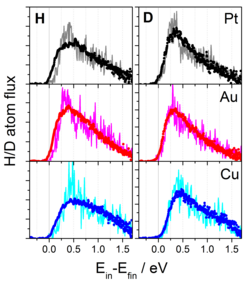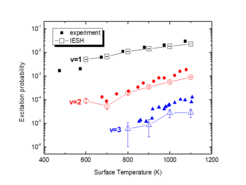First principles simulations of molecule-surface dynamics
One of the most distinctive features of the atomic and molecular scattering from metal surfaces is the dominant role of the electronically nonadiabatic effects in the energy loss, and consequently, adsorption processes. This indicates the breakdown of the Born-Oppenheimer approximation, which assumes that the motion of electrons could be decoupled from that of nuclei. So, performing reliable molecular dynamics (MD) simulations demands an adequate and effective propagation algorithm accounting for the nonadiabaticity as well as an accurate potential energy surface (PES), on which nuclei move.
Our group focuses on the following systems:

Figure 1. Energy loss spectra for H/D atoms derived from the theory (solid lines) and the experiment (circles). Incidence conditions are: Ein = 2 eV, ϑin =45◦.
- Hydrogen scattering from fcc metal surfaces. We can justly model this assuming a weak coupling between nuclear and electronic degrees of freedom and using the MD with electronic friction (MDEF). It propagates the nuclei on the ground-state PES and accounts for the interactions with electrons of a metal on the level of Langevin dynamics, i.e., in terms of a drag and stochastic forces. The most important parameter here is the “electronic friction” coefficient, which describes the cumulative effect due to excitation of a large amount of low-energy electron-hole pairs. This model was very successful in reproducing the measured energy loss spectra obtained for H scattering from various metals revealing the decisive role of the nonadiabatic effects for energy transfer to the surface. The theory was also capable to explain very weak isotope effect by the compensation of adiabatic and nonadiabatic contributions to the energy losses (Fig. 1);
- Scattering of diatomic molecules from fcc metal surfaces. For this system the weak coupling approximation does not work, so we apply more advanced technique – Independent Electron Surface Hopping (IESH) – to model the nonadiabatic dynamics. Here, the electron dynamic is handled by solving Schroedinger equations for electrons, and a special stochastic procedure is applied to select an electronic state, defining the corresponding PES to propagate the nuclei with classical MD. The IESH works very well in describing the scattering experiments as shown in Fig. 2, for ground-state NO at gold surface.

Figure 2. Surface temperature dependence of vibrational excitation probabilities for NO(v=0) scattered from Au(111) surface.
Computational Facilities. Our group has a moderate-size local cluster (about 800 cores) located at the IT department. Besides, we routinely use GWDG computational cluster, and Garching supercomputer facility (GRZ)
References
1. A. Kandratsenka, , H. Jiang, Y. Dorenkamp, S. M. Janke, M. Kammler, O. Buenermann, A. M.Wodtke, Unified description of H-atom-induced chemicurrents and inelastic scattering, PNAS, 2018/115, 680.
2. O. Buenermann, H. Jiang, Y. Dorenkamp, A. Kandratsenka, S. M. Janke, D. J. Auerbach and A. M. Wodtke, Electron-hole pair excitation determines the mechanism of hydrogen atom adsorption, Science 2015/DOI:10.1126/science.aad4972
3. S. M. Janke, D. J.Auerbach, A. M.Wodtke, and A.Kandratsenka, An accurate full-dimensional potential energy surface for H–Au(111): Importance of non-adiabatic electronic excitation in energy transfer and adsorption, Journal of Chemical Physics 2015/143, 124708.
4. B. C. Krüger, N. Bartels, C. Bartels, A. Kandratsenka, J. C. Tully, A. M.Wodtke, and T. Schäfer, NO vibrational energy transfer on a metal surface: Still a challenge to first-principles theory, Journal of Physical Chemistry C 2015/119, 3268

